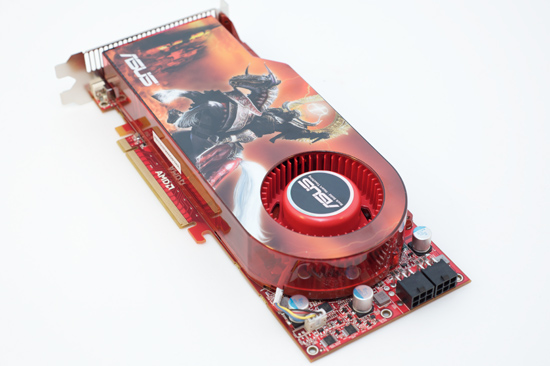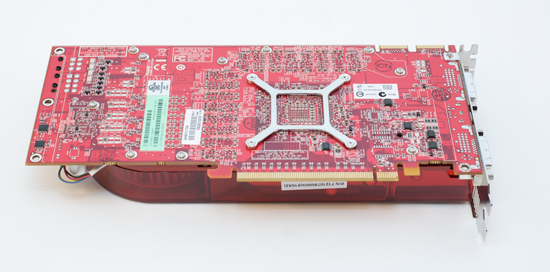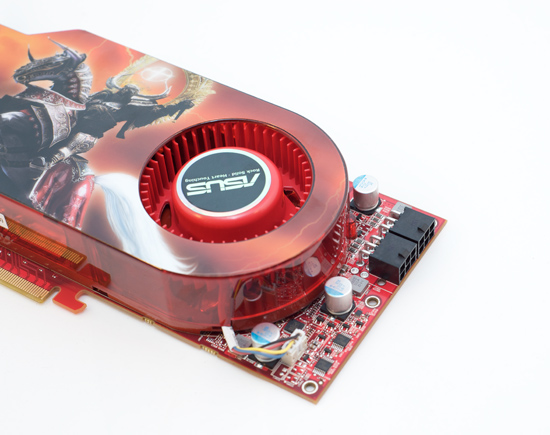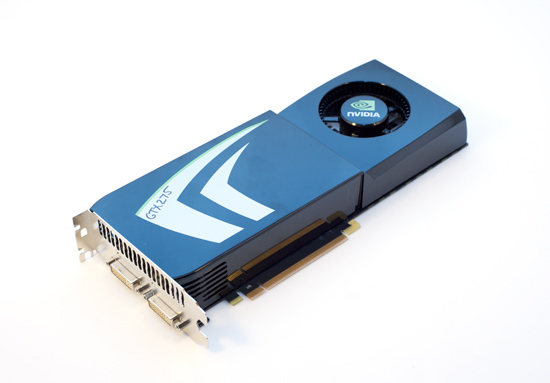ATI Radeon HD 4890 vs. NVIDIA GeForce GTX 275
by Anand Lal Shimpi & Derek Wilson on April 2, 2009 12:00 AM EST- Posted in
- GPUs
The Cards and The Test
In the AMD department, we received two cards. One was an overclocked part from HIS and the other was a stock clocked part from ASUS. Guess which one AMD sent us for the review. No, it's no problem, we're used to it. This is what happens when we get cards from NVIDIA all the time. They argue and argue for the inclusion of overclocked numbers in GPU reviews when it's their GPU we're looking at. Of course when the tables are turned so are the opinions. We sincerely appreciate ASUS sending us this card and we used it for our tests in this article. The original intent of trying to get a hold of two cards was to run CrossFire numbers, but we only have one GTX 275 and we would prefer to wait until we can compare the two to get into that angle.



The ASUS card also includes a utility called Voltage Tweaker that allows gamers to increase some voltages on their hardware to help improve overclocking. We didn't have the chance to play with the feature ourselves, but more control is always a nice feature to have.

For the Radeon HD 4890 our hardware specs are pretty simple. Take a 4870 1GB and overclock it. Crank the core up 100 MHz to 850 MHz and the memory clock up 75 MHz to 975 MHz. That's the Radeon HD 4890 in a nutshell. However, to reach these clock levels, AMD revised the core by adding decoupling capacitors, new timing algorithms, and altered the ASIC power distribution for enhanced operation. These slight changes increased the transistor count from 956M to 959M. Otherwise, the core features/specifications (texture units, ROPs, z/stencil) remain the same as the HD4850/HD4870 series.
Most vendors will also be selling overclocked variants that run the core at 900 MHz. AMD would like to treat these overclocked parts like they are a separate entity altogether. But we will continue to treat these parts as enhancements of the stock version whether they come from NVIDIA or AMD. In our eyes, the difference between, say, an XFX GTX 275 and an XFX GTX 275 XXX is XFX's call; the latter is their part enhancing the stock version. We aren't going to look at the XFX 4890 and the XFX 4890 XXX any differently. In doing reviews of vendor's cards, we'll consider overclocked performance closely, but for a GPU launch, we will be focusing on the baseline version of the card.
On the NVIDIA side, we received a reference version of the GTX 275. It looks similar to the design of the other GT200 based hardware.

Under the hood here is the same setup as half of a GTX 295 but with higher clock speeds. That means that the GTX 275 has the memory amount and bandwidth of the GTX 260 (448-bit wide bus), but the shader count of the GTX 280 (240 SPs). On top of that, the GTX 275 posts clock speeds closer to the GTX 285 than the GTX 280. Core clock is up 31 MHz from a GTX 280 to 633 MHz, shader clock is up 108 MHz to 1404 MHz, and memory clock is also up 108 MHz to 2322. Which means that in shader limited cases we should see performance closer to the GTX 285 and in bandwicth limited cases we'll still be faster than the GTX 216 because of the clock speed boost across the board.
Rather than just an overclock of a pre-existing card, this is a blending of two configurations combined with an overclock from the two configurations from which it was born. And sure, it's also half a GTX 295, and that is convenient for NVIDIA. It's not just that it's different, it's that this setup should have a lot to offer especially in games that aren't bandwidth limited.
That wraps it up for the cards we're focusing on today. Here's our test system, which is the same as for our GTS 250 article except for the addition of a couple drivers.
The Test
| Test Setup | |
| CPU | Intel Core i7-965 3.2GHz |
| Motherboard | ASUS Rampage II Extreme X58 |
| Video Cards | ATI Radeon HD 4890 ATI Radeon HD 4870 1GB ATI Radeon HD 4870 512MB ATI Radeon HD 4850 NVIDIA GeForce GTX 285 NVIDIA GeForce GTX 280 NVIDIA GeForce GTX 275 NVIDIA GeForce GTX 260 core 216 |
| Video Drivers | Catalyst 8.12 hotfix, 9.4 Beta for HD 4890 ForceWare 185.65 |
| Hard Drive | Intel X25-M 80GB SSD |
| RAM | 6 x 1GB DDR3-1066 7-7-7-20 |
| Operating System | Windows Vista Ultimate 64-bit SP1 |
| PSU | PC Power & Cooling Turbo Cool 1200W |










294 Comments
View All Comments
san1s - Thursday, April 2, 2009 - link
why didn't you post a page on how useless dx 10.1 is? I bet that there will be even less difference in gameplay with dx10.1 on compared to dx10 than physxAnandThenMan - Friday, April 3, 2009 - link
10.1 can bring some meaningful performance boosts.http://img7.imageshack.us/img7/1757/hd489064.jpg">http://img7.imageshack.us/img7/1757/hd489064.jpg
SiliconDoc - Monday, April 6, 2009 - link
ati can't do physx at all - so uhh, no performance boost there, EVER.Same with cuda.
Kinda likewise with this cool Vreveal clean up video thingie.
Same with the badaboom converter compared to ati's err(non mentioned terrible implementation)...lol hush hush!!! doesn't matter ! doesn't matter ! nothing going on there !
tamalero - Thursday, April 9, 2009 - link
hu, gpu phsyx gpu aceleration only helps when theres heavy physx caltulations.almost no game uses that heavy calculations nowadays.
besides, if you wanted physix to run, dont you need a second card to run physX while the other does the graphics?
I suspect thers a slowdown as well if the same graphic card does the work.
SiliconDoc - Friday, April 24, 2009 - link
Since you suspect there's a slowdown with PhysX enabled it points out two things to me : 1. you have no clue if there is because you don't have an nvidia card, indicating your red rooster issue.2. That's why you didn't get my point when the other poster linked to the other review and listed the various settings and I laughed while pointing out the NV said PhysX enabled.
_______
It's funny how your brain farts at just the wrong time, and you expose your massive experience weakness:
"you suspect" - you don't know.
Go whine at someone else, or don't at all. At least bring a peashooter to the gunfight.
Ever played War Monger or Mirror's Edge ? lol
No of course not! YOU CAN'T, until, you know.
yacoub - Thursday, April 2, 2009 - link
Given that you label the price for the GTX260-216 as $205, and in reality it's closer to $175, can we expect the 275 will be closer to $215 in short order?yacoub - Thursday, April 2, 2009 - link
Of course ATi has a hard launch of this product - its hardware appears from your description to be identical to existing hardware just with a slight clockspeed boost, where as the GTX-275 is actually a break between the 285 and the 260.Also the 275 is much more appealing given that it has actual hardware improvements over the 260 for just a bit more cash.
chrnochime - Thursday, April 2, 2009 - link
Did you actually bothered to read other comments wrt the fact that the RV790 is a respin, not just bump in gpu/mem clkspeed??And the actual hardware improvements that are just cut-down from the GTX295. Big deal. Appealing to the NV fanboys, sure.
7Enigma - Friday, April 3, 2009 - link
It's possible he saw the article before Anand/Gary corrected the table. Originally the table had identical numbers between the 4870 and 4890. And in the text they mentioned that it was basically an OC'd 4870. This could lead one to assume it was pretty much the same card. In the article (on the next page) they did mention quickly the high transistor count, but it was brushed over quickly and they didn't really go into detail about the differences (still waiting to get a response about the cooling solution changes).As for the rest of his post, he IS clearly an Nvidia fanboy, because the 4890 is clearly the better product in just about every case (not even looking at the OC'ing potential which seems to be very nice).
SiliconDoc - Monday, April 6, 2009 - link
Hmm, better in every case, without the overclocking potential ? lol He's a fanboy ?Is it better with Cuda, curing cancer with Folding, Vreveal clean up video recoding, forced game profiles, dual GPU game forcing ? Any of those have an as good equivalent ? NO NOT ONE.
So you know dude, he's not the fanboy...
The thing is, ati did a good job with the ring around the gpu 3m transistors to cut down frazzly electric - and gain a good overclock.
That they did well. They also added capacitors and voltage management to the card - an expense left - not mentioned in expense terms - including the larger die cost.
So, on the one hand we have a rebranded overclock that merely used the same type of core reworking that goes into a shrink, but optimized for clocks with a transistor band around the outside.
Not a core rework, but a very good refinement.
I knew the intricacies would be wailed about by the red fans, but not a one is going to note that the G80 is NOT the same as the G92b - the refinements happened there as well in the die shrink, and in between, just like they do on cpu revisions.
Since ATI was making and overclocking upgrade, they needed to ring the core - and make whatever rearrangements were neccessary to do that.
Purely rebrand ? Ahh, not really, but downclocking it to the old numbers may (likely) reveal it's identical anyway.
At that point rebrand is tough to get away from, since the nvidia rebrands offered core revision and memory/clock differences, as well.
I'll give ati a very slight edge because of the ring capacitors, which is interesting, and may be due to the ddr5, that made their core viable for competition to begin with, instead of just a 9800X equivalent, the 4850 - minus the extra capabilities - cuda, better folding, physx, forced sli, game profiles - etc... vreveal... and on and on - evga game drivers on release day - etc. - oh the uhh.. ambient occlusion and fear + many other game mods for it...
Anyway, tell me none of that matters with a straight face - and that face will be so red you'll have to pay in wampum at the puter store.